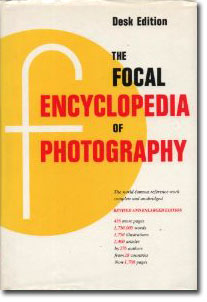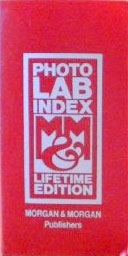Shelf 7 - Reference
©opyright by James Ollinger. All rights reserved.
Contents:
|

Focal Press :Focal Encyclopedia of Photography (desk edition)
My copy is from 1960 but it's still quite useful. While it's obsolete in some examples and a half-century of new information is not there, what is there is amazing and worthwhile.
For a desktop encyclopedia, it's suprisingly comprehensive. Name a subject (pre 1960) and it's likely to be in here somewhere. And it's not just a lot of single-paragraph explanations of terms, many things are discussed and explained at length. I just flipped it open to a random page: Hyperstereoscopy. Beyond the basics, it differentiates between Terrestrial, Aerial and Astronomical. Where else except a stereo-photography book (if there) are you going to find anything about hyperstereoscopy at all?
The one caveat for American readers (like myself) is that's from the UK and occasionally the US/UK term differences show up, as well as UK spelling (colour). Still, I think it's an excellent book. Usually inexpense—if you get a chance to look through one, by all means do. I think you'll be pleasantly surprised.

Morgan & Morgan :Photo Lab Index
I started darkroom work in the pre-internet days. There was a ton of information out there but you had to hunt, collect and store like a squirrel with a cache of nuts. A prime resource was the paper data sheets that came with a roll of film or a box of paper. I had a drawer full of them. And I had various Kodak books that listed their products and how to use them, plus books with other data, and copies and magazine articles. . . . you get the idea.
In the late 1930s, Morgan & Lester collected as much data as they could and published it together as the Photo Lab Index (PLI); so now you just had to pop the book open, find the data on your film, paper, chemistry, filter, or whatever, and there it was. No more wading through hundreds of pages of paper.
Morgan & Lester (later Morgan & Morgan) published a couple of different versions. One was a traditional book which would be supseded every few years by an updated edition. The other was the Lifetime edition, which was loose-leaf. Initially when you bought this thing you would get the base, up-to-date book, and then quarterly they would send a packet of pages for you to update your book. There was complicated pagination system because you had to take out pages for discontinued stuff, add new pages for new stuff, and replace pages for stuff that was extant but changed somehow. Making these changes was no fun at all. I still find an occasional example where I screwed something up (which is why you never throw out the old pages...).
I've got two, the original edition from 1939 and a modern edition (as pictured), both Lifetimes. The differences are interesting: the original is relatively slim; the modern one is very thick and heavy. The original was spiral bound and lays flat on the table; the new one is too big and unwieldy, so the spine is just designed to hold the thing together and that's it.
I believe the PLI is now out of print since this is exactly the kind of data you can get on the internet for free, plus it's (hopefully) up-to-date, whereas there was always a lag between when products came out and when the new PLI pages arrived.
So should you get one? If it's cheap: sure, why not? While most of the data on film and papers are obsolete, there's a lot of stuff on filters and other things that are still applicable. If you like brewing your own photochemicals, the section in the back with formulae is worth the money on its own.
But I wouldn't pay much for it. All of this data are available elsewhere, most of it on the internet for free. You just have to hunt, collect and store...
 C. B. Neblette : Photography, It's Principles and Practice
C. B. Neblette : Photography, It's Principles and Practice
This may be the single most boring book I've ever read. I believe it was written as a textbook for a photography course; first edition is 1927 and my 4th edtion is from 1942, so it's got that era's textbook gravitas and dry-as-Death-Valley prose, except that it's the leading example of it. Gray's Anatomy is a livlier read.
Even though it's very dated and mostly obsolete, there is a lot of information here: a capsule history of photography, more on optics than you'll find in any modern photo text, and a lot of detail on photochemistry and sensitometry. But there's nothing in this thing that can't be found elsewhere in a more accessible and readable format. Not recommended at all.